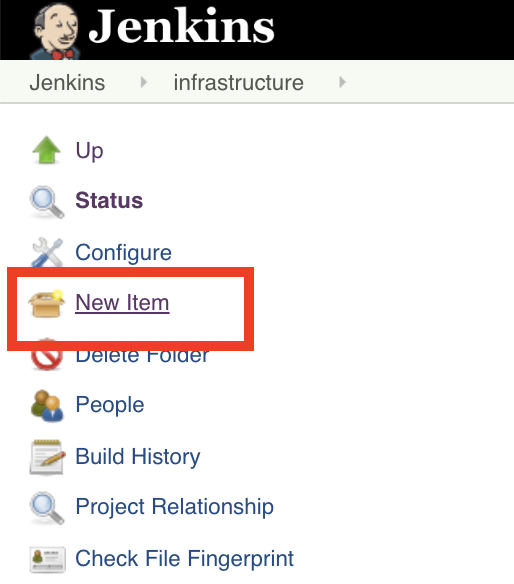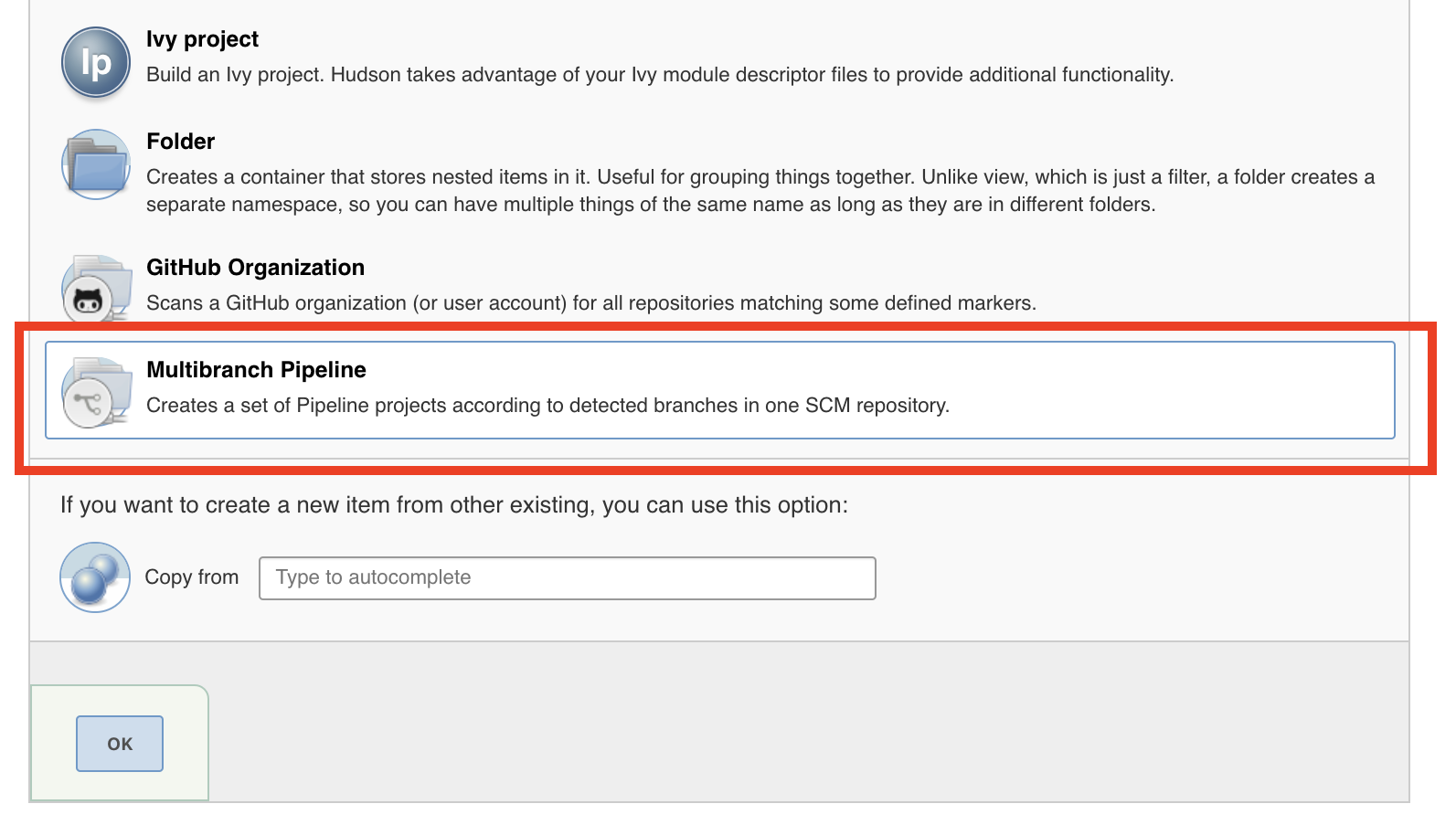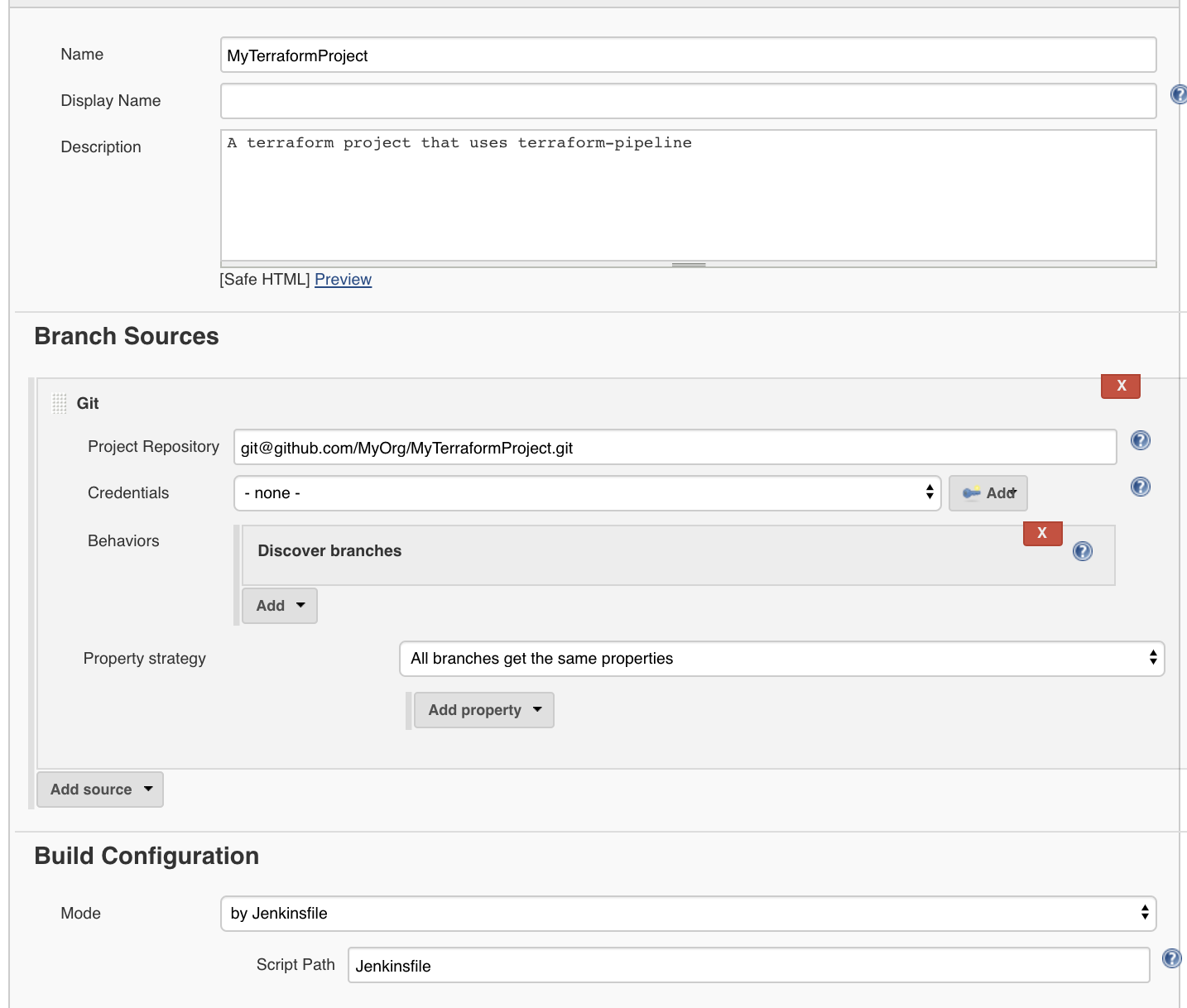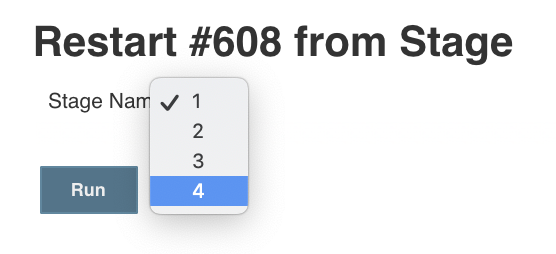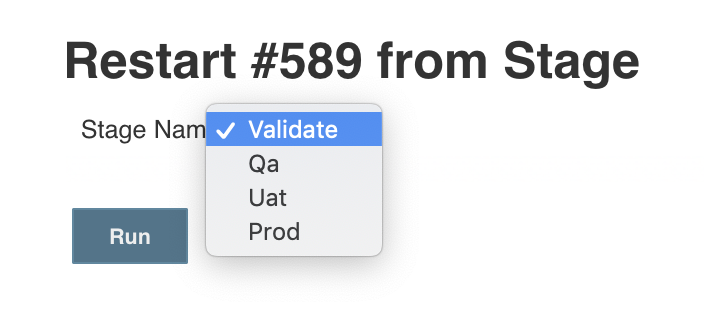A reusable pipeline template to apply terraform configuration serially across multiple environments.
- You have a separate terraform project that can be run with the following commands:
terraform initterraform planterraform apply
- After running a terraform plan, your pipeline will pause. A human must review and confirm the plan before
terraform applyis run. See: ConfirmApplyPlugin. - When running your pipeline on a branch, only the
terraform initandterraform plancommands will be run across all of your environments.terraform applyis only made available on the main branch. See: ConditionalApplyPlugin. - If your environments might create conflicting resources, a TF_VAR_environment variable is automatically available to your project and can be used to namespace your resources and avoid conflicts. See: DefaultEnvironmentPlugin.
- Import terraform-pipeline as a Jenkinsfile library to your Jenkins instance.
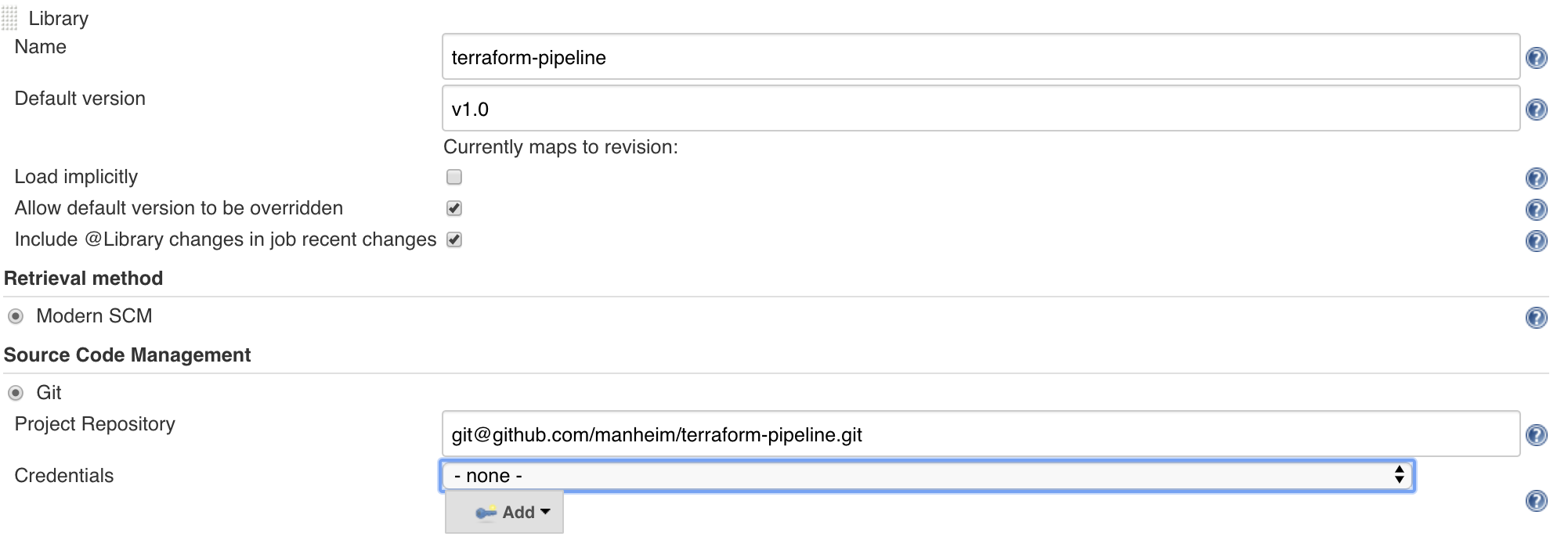
- Create a Jenkinsfile in your terraform project and import the version of terraform-pipeline that you want to use. The example below uses
v5.1, but it's recommended that you always use the latest version - unreleased changes are queued in the master branch, so using master may cause unexpected results.
// Jenkinsfile
@Library(['terraform-pipeline@v5.1']) _
- Provide terraform-pipeline with a reference to the Jenkinsfile context, so it can do all of it's magic under the hood.
// Jenkinsfile
...
Jenkinsfile.init(this)
- Start your pipeline with a syntatic analysis of your terraform project (this is optional, but highly recommended)
// Jenkinsfile
...
def validate = new TerraformValidateStage()
- Create deployment Stages for each of the environments that you would normally deploy to. This example creates terraform resources for qa, uat, and prod environments. The number and names of your environments can differ from this example. Choose the environments and environment names that reflect your own development process to go from Code to Customer.
// Jenkinsfile
...
def deployQa = new TerraformEnvironmentStage('qa')
def deployUat = new TerraformEnvironmentStage('uat')
def deployProd = new TerraformEnvironmentStage('prod')
- Link the Stages together in the order that you want them to run. This examples first does a syntactic validation, then deploys qa, then uat, then prod. Each step MUST succeed before it can proceed on to the next.
// Jenkinsfile
...
validate.then(deployQa)
.then(deployUat)
.then(deployProd)
- The design of this library is influenced by the Builder Pattern - your pipeline has been configured, but hasn't been constructed just yet. Finalize and create your pipeline by calling the
build()method. This should only be done once - no code should come after calling this method.
// Jenkinsfile
...
.build()
- From beginning to end, your Jenkinsfile should roughly look like this:
@Library(['terraform-pipeline@v5.1']) _
Jenkinsfile.init(this)
def validate = new TerraformValidateStage()
def deployQa = new TerraformEnvironmentStage('qa')
def deployUat = new TerraformEnvironmentStage('uat')
def deployProd = new TerraformEnvironmentStage('prod')
validate.then(deployQa)
.then(deployUat)
.then(deployProd)
.build()
-
Load your project into Jenkins, and point it to your newly created Jenkinsfile.
-
If everything was successful, you should see something like this:
The example above gives you a bare-bones pipeline, and there may be Jenkinsfile features that you'd like to take advantage of. Some of these features have been pre-defined as Plugins for this library. Pre-defined plugins can be enabled by simply calling their static init() method.
- BuildWithParametersPlugin: use this plugin to manage the "Build with Parameters" feature of pipelines.
- ConfirmApplyPlugin: pause and review the plan, before applying any changes.
- ConditionalApplyPlugin: only allow apply on main branch.
- DefaultEnvironmentPlugin: automatically set
TF_VAR_environmentvariable. - TerraformPlugin: apply version-specific terraform behavior based on the version of terraform in use.
- CredentialsPlugin: Inject Jenkins credentials into your stages.
- FileParametersPlugin: Use properties files to inject environment-specific variables.
- ParameterStoreBuildWrapperPlugin: Inject environment-specific variables using
withAwsParameterStore. - ParameterStoreExecPlugin: Inject environment-specific variables using parameter-store-exec.
- TagPlugin: Inject tags as a terraform variable.
- TfvarsFilesPlugin: Add environment specific tfvars files to your plan and apply commands.
- AwssumePlugin: Use the awssume gem to assume different IAM roles.
- WithAwsPlugin: Use
withAwsto assume different IAM roles.
- ConsulBackendPlugin: Use Consul backend to manage terraform state.
- S3BackendPlugin: Use S3 backend to manage terraform state.
- FlywayMigrationPlugin: Use Flyway to automate your database migrations.
- AgentNodePlugin: Run your pipeline on agents that are configured with Docker.
- AnsiColorPlugin: Enable ansi-color output.
- DestroyPlugin: Use this to change the pipeline functionality to
terraform destroy. (Requires manual confirmation) - GithubPRPlanPlugin: Use this to post Terraform plan results in the comments of a Github PullRequest.
- PassPlanFilePlugin: Pass the plan file into apply stage
- PlanOnlyPlugin: Use this to change the pipeline functionality to
terraform planonly. - TargetPlugin: set
-targetparameter for terraform plan and apply. - TerraformDirectoryPlugin: Change the default directory containing your terraform code.
- TerraformStartDirectoryPlugin: Change the starting execution workspace directory.
- TerraformEnvironmentStageShellHookPlugin: Run arbitrary shell scripts at various points in the TerraformEnvironmentStage process.
- TerraformLandscapePlugin: Enable terraform-landscape plan output.
- ValidateFormatPlugin: Validate correct code format as part of the TerraformValidateStage.
This library was intended to be customizable and extendable - if you don't find a predefined plugin for a feature that you need or want, feel free to create your own.
- Create your own shared library. See: DRY'ing your Plugin configuration
- Create a
srcfolder, and create a groovy file for your plugin. - Define your class, and implement the appropriate Plugin interface, depending on which Stage or Command your plugin will affect. (Eg: TerraformEnvironmentStagePlugin, TerraformApplyCommandPlugin, etc).
- Define a
public static init()method, then add an instance of your plugin to each of the Stages/Commands that it will modify. (Eg: AnsiColorPlugin) - Import your shared library into your Jenkinsfile.
- Call your
init()method in your Jenkinsfile before callingbuild()on your pipeline. - If your plugin could be useful to others, feel free to put in a Pull Request.
Plugins often work by wrapping your stages in Jenkinfile DSL blocks. If multiple plugins wrap your stages simultaneously, the order in which they are wrapped can be very important. On the whole, terraform-pipeline strives to preserve and maintain the order you initialize the plugins, so that the corresponding Jenkinsfile DSL blocks execute predictably.
Take the following example:
ParameterStoreBuildWrapperPluginwraps your pipeline stages with the Jenkinsfile DSLwithAWSParameterStore { }and can inject environment variables into your stage from ParameterStore key/value pairs.WithAwsPluginwraps your pipeline stages with the Jenkinsfile DSLwithAws { }and can execute your stage under the context of an IAM role that's defined by an environment variable.- The two plugins can be used together - an IAM role can be defined in ParameterStore and translated to an environment variable
AWS_ROLE_ARN, and that environment variable can in turn be used to configure the IAM role assumed byWithAwsPlugin.
Using terraform-pipeline, you might initialize your pipeline as such:
// Wrap everything before this in withAWS { }
WithAwsPlugin.init()
// Wrap everything before this in withAWSParameterStore { }
ParameterStoreBuildWrapperPlugin.init()
The above would generate roughly the following Jenkinsfile DSL:
...
// Set a key value pair in ParameterStore so that AWS_ROLE_ARN=<SomeArn>
withAWSParameterStore {
...
// AWS_ROLE_ARN was set by ParameterStore
// AWS_ROLE_ARN is picked up and used by withAWS
withAWS(role: AWS_ROLE_ARN) {
...
}
}
...
The order in which the plugins were initialized determined the order of the Jenkinsfile DSL. Had the plugins been initialized in the reverse order, the Jenkinsfile DSL would likewise be reversed, and would lead to an undesirable outcome.
// Wrap everything before this in withAWSParameterStore { }
ParameterStoreBuildWrapperPlugin.init()
// Wrap everything before this in withAWS { }
WithAwsPlugin.init()
...
// AWS_ROLE_ARN is not defined - withAWS does nothing
withAWS(role: <?>) {
...
// AWS_ROLE_ARN=<SomeArn> is defined in ParameterStore, but it's too late
withAWSParameterStore {
...
}
}
...
By default, the pipeline jobs are not assigned to a particular Jenkins slave label. If you want to tie your pipeline to particular Jenkins slave label, you can do so with the following line of code:
Jenkinsfile.defaultNodeName = 'myNode'
Alternatively, you can assign all of your pipelines to a particular Jenkins agent label without using code, by setting a DEFAULT_NODE_NAME environment variable on your Jenkins server.
- TerraformEnvironmentStage - run terraform plan & apply
- BuildStage - build a deployment artifact that will subsequently be used by TerraformEnvironmentStage.
- RegressionStage - run automated tests against an environment
DRY'ing your Plugin configuration
It's likely that you'll use a number of different Plugins for your particular terraform-pipeline application. It's also likely that you'll have a number of different applications using terraform-pipeline, and many of these applications may share the same plugin configuration. Rather than duplicate and clutter your Jenkinsfile with these details, you can group all of your Plugin initialization into a single class, and share that class across your pipelines with a shared library.
- Create a new repository for the shared library called
terraform-pipeline-customizations. - In that repository, create a new file called
Customizations.groovy. - Create a static
init()method in your class, and add your Plugin configuration there. In the example below, the Customization will enable the AnsiColorPlugin, and the ParameterStoreBuildWrapperPlugin by default.
// Customizations.groovy
class Customizations {
public static void init() {
AnsiColorPlugin.init()
ParameterStoreBuildWrapperPlugin.init()
}
}
- Load your repository as a shared library (See: Using Libraries).
- Import your shared library and pass your Customization class to the Jenkinsfile.init() method. Like terraform-pipeline, it's a good practice to strictly control your customization library versions.
// Jenkinsfile
@Library(['terraform-pipeline@v5.1', 'terraform-pipeline-customizations@v1.0']) _
Jenkinsfile.init(this, Customizations)
...
- Repeat Step 5 above for every project that you want to apply your Customzations to.
Jenkinsfile has a number of quirks, which in turn creates a number of frustrating short-comings. The most noticeable quirk is the two distinctive syntaxes for creating a pipeline:
Scripted Pipelines are much easier to work with, and offer a lot of flexibility and programmability. Declarative Pipelines on the otherhand, are much less flexible, but offer the really important feature known as 'Restart From Stage' - the ability to re-run portions of a previous pipeline run.
terraform-pipeline attempts to abstract away these two different types of pipelines, so that you can get the features that you want, without needing to write your pipeline code in a specific/arbitrary way.
By default, your pipeline will be a Scripted Pipeline. You can convert your pipeline to a Declarative Pipeline by enabling a flag:
Jenkinsfile.declarative = true
A short-coming of Declarative Pipelines is the inability to use variables when defining Stage names (See: JENKINS-43820). The compromise made by terraform-pipeline is to name each of the top-level Stage names using consecutive numbers '1', '2', '3', etc. The following code:
@Library(['terraform-pipeline']) _
Jenkinsfile.init(this)
Jenkinsfile.declarative = true
def validate = new TerraformValidateStage()
def qa = new TerraformEnvironmentStage('qa')
def uat = new TerraformEnvironmentStage('uat')
def prod = new TerraformEnvironmentStage('prod')
validate.then(qa)
.then(uat)
.then(prod)
.build()
will produce a Declarative Pipeline that looks like this:
When using the Restart from Stage feature, you'll need to map the numbered Stages to the Stages that you've defined in your Jenkinsfile. In this example, 1 = Validate, 2 = Qa, 3 = Uat, 4 = Prod.
Mapping arbitrary numbers to your Stages can likely be annoying. If you want to give your Stages more meaningful names, you can override the underlying Declarative Pipeline template with your own, using the Jenkinsfile.pipelineTemplate variable, and a Customizations library (See: DRY'ing your Plugin Configuration).
As an example, we'll create a vars/CustomPipelineTemplate.groovy in our customizations library, and define top-level Stages that match the Stages of our pipeline - Validate, Qa, Uat, and Prod.
// terraform-pipeline-customizations/vars/CustomPipelineTemplate.groovy
def call(args) {
pipeline {
agent none
stages {
stage('Validate') {
steps {
script {
((Stage)args.getAt(0)).build()
}
}
}
stage('Qa') {
steps {
script {
((Stage)args.getAt(1)).build()
}
}
}
stage('Uat') {
steps {
script {
((Stage)args.getAt(2)).build()
}
}
}
stage('Prod') {
steps {
script {
((Stage)args.getAt(3)).build()
}
}
}
}
}
}
In your Jenkinsfile, override the default pipelineTemplate, and point it to your new pipeline template function. For example:
@Library(['terraform-pipeline', 'terraform-pipeline-customizations']) _
Jenkinsfile.init(this)
Jenkinsfile.declarative = true
Jenkinsfile.pipelineTemplate = this.CustomPipelineTemplate
def validate = new TerraformValidateStage()
def qa = new TerraformEnvironmentStage('qa')
def uat = new TerraformEnvironmentStage('uat')
def prod = new TerraformEnvironmentStage('prod')
validate.then(qa)
.then(uat)
.then(prod)
.build()
This will generate a new Declarative Pipeline, using your custom template.
Restart from Stage will now display more sensible names. Note: This is in NO way dynamic. If you reorder the Stages in your Jenkinsfile, you'll need to reorder the Stage names in your custom template. This is an unfortunate side-effect of the strict syntax of Declarative Pipelines.
Some versions of terraform have made changes that affect a pipeline's workflow, eg: backend changes between v0.11 and v.12. TerraformPlugin provides a hooking point to addressing these, and future, differences.
By default, the plugin will detect a .terraform-version file in the root of your repo and adjust the terraform workflow accordingly. Alternatively, you can declare your terraform version explicitly in code:
// Jenkinsfile
Jenkinsfile.init(this)
TerraformPlugin.withVersion('0.12.17')
If no .terraform-version file is found, and no explicit version is provided, the default version assigned by the library is 0.11.0. This preserves all behavior prior to the introduction of this default plugin.
- Create an Issue for the change that's being made.
- All changes pending the next release will be staged in the master branch.
- Fork this project.
- Make a branch named after your issue, in your fork.
- Make your changes in the branch and run the tests and codestyle checks with with
./gradlew check --info - Update the CHANGELOG with your changes. Changes are queued under "Unreleased", until an official release is cut.
- Validate your changes by pointing a terraform-pipeline project to your fork's branch, and run an actual pipeline.
- Make a PR against the master branch of this project, and reference your Issue in the PR.
- Your PR will be reviewed and merged into master.
- Changes in master will be periodically grouped and published as a Release.
- Just like our application code, infrastructure code should be written once, and should be reusable for all environments.
- Configuration, especially environment-specific configuration, should be externalized. Where it's externalized to should be irrelevant.
- As much as possible, a pipeline should reflect what teams do to get from Code to Customer - no more, but also no less.
- Allow teams to specify their own steps in that process, and teams should choose how those steps are linked together.
- This is an OpenSource project - defaults should make reasonable sense for anyone that happens to use this project.
- Apply the Open/Closed Principle
- You should rarely need to change the base code, everything should be open for extension without modification to the base code.
- It should be possible to add behaviors through Plugins and Decorations - this makes behavior addable/removable/extenable.
- Think of plugins as interchangeable Lego pieces - you can swap one piece out for another, without fundamentally altering what it is to be a Pipeline.
- There should only be one way to Production, and that way should be crystal clear.
- The main branch (or its equivalent) is the one-and-only way to Production.
